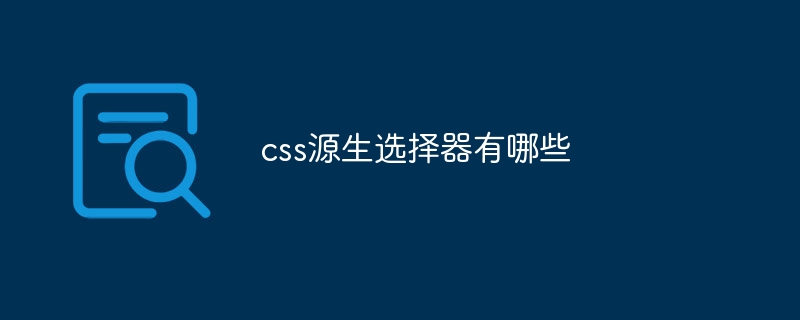
css source selectors include element selectors, class selectors, ID selectors, attribute selectors, pseudo-class selectors, pseudo-element selectors, descendant selectors, child element selectors, and adjacent siblings Selectors and universal selectors, etc. Detailed introduction: 1. Element selector, use the element name as the selector, select all elements in the document that match the element name; 2. Class selector, use the class name as the selector, select all elements with the same class name in the document , the class name starts with a dot; 3. ID selector, using the unique ID of the element as the selector, etc.

The operating system for this tutorial: Windows 10 system, DELL G3 computer.
CSS (Cascading Style Sheet) is a language used to describe the style of web pages, which can control the appearance and layout of elements in web pages. In CSS, selectors are used to select elements to which styles should be applied. CSS selectors can be divided into two types: native selectors and custom selectors. This article will focus on CSS’s raw selectors.
1. Element Selector: Use the element name as the selector to select all elements in the document that match the element name. For example, the p selector will select all paragraph elements.
2. Class Selector: Use the class name as the selector to select all elements with the same class name in the document. Class names begin with a period (.). For example, the .red selector will select all elements with class name red.
3. ID Selector: Use the unique ID of the element as the selector to select the element with the corresponding ID in the document. IDs start with a pound sign (#). For example, the #header selector will select the element with the ID header.
4. Attribute Selector: Use the attributes of elements as selectors to select elements with corresponding attributes in the document. There are many forms of attribute selectors, including [attribute] selector (selecting elements with specified attributes), [attribute=value] selectors (selecting elements with specified attributes and values), etc.
5. Pseudo-class Selector: Use the specific state of an element as a selector to select elements with the corresponding state in the document. Pseudo-class selectors begin with a colon (:). For example, the :hover selector will select the state when the mouse is hovering over the element.
6. Pseudo-element Selector: Use a specific part of an element as a selector to select elements with corresponding parts in the document. Pseudo-element selectors begin with a double colon (::). For example, the ::before selector will select content inserted before the element.
7. Descendant Selector: Use two selectors separated by spaces to select elements in the document that match the second selector and are descendant elements of the first selector. For example, the div p selector will select all paragraph elements within a div element.
8. Child Selector: Use two selectors separated by a greater than sign (>) to select the element in the document that matches the second selector, and the element is the first The direct child element of the selector. For example, the div > p selector will select paragraph elements that are direct children of all div elements.
9. Adjacent Sibling Selector: Use two selectors separated by a plus sign ( ) to select the element in the document that matches the second selector, and the element immediately follows the Behind a selector. For example, the h1 p selector will select the paragraph element immediately following the h1 element.
10. Universal Selector: Use asterisk (*) as the selector to select all elements in the document. Universal selectors can be combined with other selectors to select specific elements.
The above are the main types of CSS source selectors. By rationally using selectors, you can accurately select and control element styles in web pages, thereby achieving rich and diverse page effects.
The above is the detailed content of What are the css source selectors?. For more information, please follow other related articles on the PHP Chinese website!